*Just to be clear, while this is a recipe for ramp pesto, you can use it as the guideline for pretty well any pesto you wish to create.
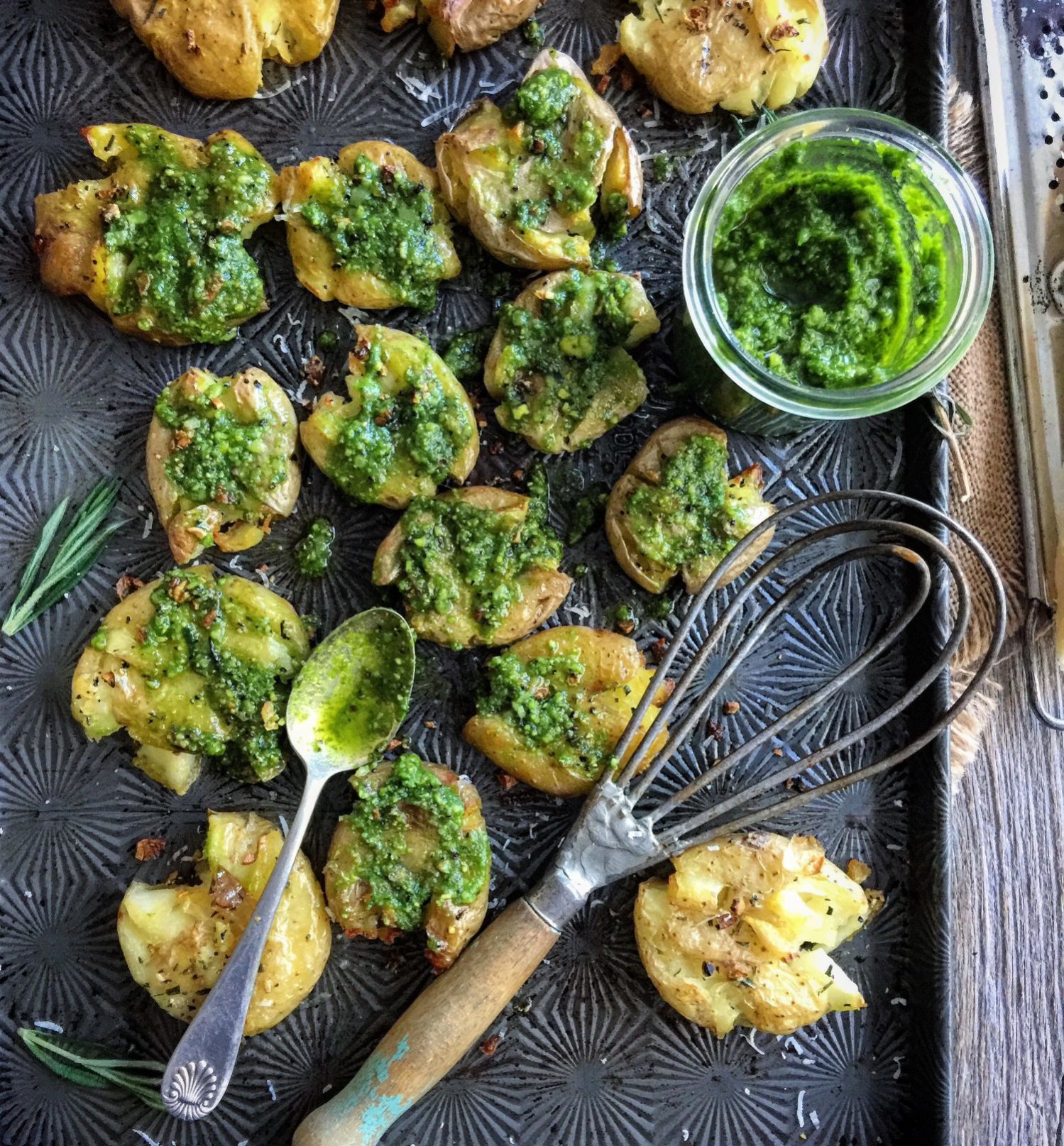 We grew up with a pretty darn big garden, considering we lived in the suburbs. We had everything you could think of: beans, carrots, cucumbers, tomatoes, melons, berries of all kinds, kale and chard, peppers, peas, onions, garlic, and the list goes on and on. And then there were the fruit trees: cherry, plum, peach. We did pretty good, considering there were only four in our family. There was a chicken coop out back as well.
We grew up with a pretty darn big garden, considering we lived in the suburbs. We had everything you could think of: beans, carrots, cucumbers, tomatoes, melons, berries of all kinds, kale and chard, peppers, peas, onions, garlic, and the list goes on and on. And then there were the fruit trees: cherry, plum, peach. We did pretty good, considering there were only four in our family. There was a chicken coop out back as well.
But that is how my parents grew up in Europe. They grew what they could, and then brought in slaughtered meat to make sausage etc with. For them, it was a way of life. Nothing romantic or nostalgic about it for them. Just life. I remember my dad telling us the stories about going out into the forest as a young boy to go mushroom picking. Early on they were taught which ones were edible, and which ones to stay away from. Those stories have always had a soft spot in my memory bank. So when I go foraging today, it is always with my father in mind.
Ramp Foraging
Up here in Ontario, Canada, we have to wait a few weeks into April before we really see anything worth pursuing as far as foraging goes. The forests and brush are pretty dormant and quiet under the slush of melting snow till March. But it doesn’t take long, and next thing you know, the ramps are up! The morels and the fiddleheads are never far behind.
Ramps may look like lily of the valley before the blooms appear, to the untrained eye. But there is a difference in the two types of leaves. Check out this link for important ways to distinguish the two. Ramps are also known as wild leeks. Or as ramson or wild garlic in Europe. Being in the allium family along with onions, ramps do have a pleasant onion/garlic taste. Lily of the Valley is a totally different genus. The leaf is wonderful on its own in a salad, and the white part is what reminds us of anything oniony. There’s a small forest back behind where I volunteer, so in April, I always come prepared: my rain boots, and a jacket that can handle trekking through the underbrush to get to the ramp patches. Because they are up before anything else really green is on the forest floor, it is pretty easy to spot those patches, usually growing in the gnarly roots of trees. A big bowl and a little spade or shovel, and I’m all set. Remember, if it doesn’t have a distinct onion aroma, it isn’t a ramp!
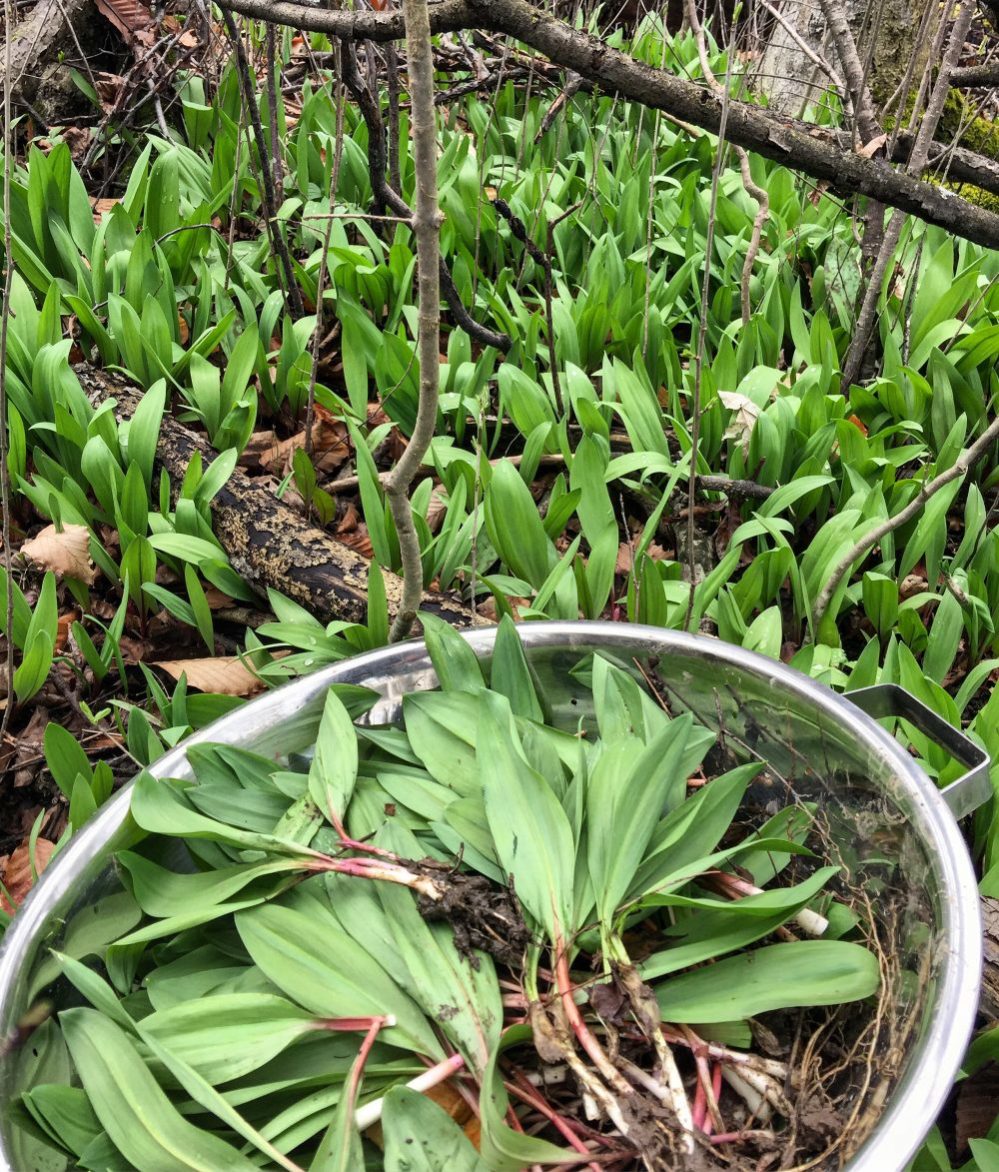
Responsible Foraging
The challenge is in the actual picking. One, never deplete a patch- aim for no more than a tenth of the patch, evenly taking from different sections of a patch. You want to leave enough that will enable the plants to continue growing for the next year. Each forest will have quite a few patches, so I try to navigate the swampy mess (it always seems to have just rained before I head out on my ramp foraging journey!) moving from patch to patch. Leave enough for the next responsible forager as well. If you are foraging in the wild where others may also forage, you may want to consider only harvesting one leaf from each plant, and leaving the root intact for future growth. Here is a great guide to responsible foraging that gives great tips, no matter where you live, and what you are foraging for.
The second challenge is in the actual harvesting of the ramp itself. If you are picking only the leaves, use scissors to cut only one leaf from each plant. Another option is is to carefully cut the bulb approximately 1 cm (1/4 inch or so) above the roots, leaving the roots intact. But this might be best for the following situation:
The following instructions are for foraging on private property where you have permission to forage. If the owners know that only you or a couple of others will be foraging, you can go ahead and take the bulb. Work from different patches that are at least 6 foot square each year, to ensure that the patches continue to flourish. Use a small shovel to dig out a small portion of leeks. Carefully go deep enough to go under the entire section. Carefully knock any loose soil back into the hole. If by accident you pulled up small ones, you can replant them in the hole, or even start a new patch.
For more great foraging tips for ramps here in Ontario, please check out this link. These past few years ramps have become more and more popular, and the demand has increased, so making adjustments in the way we forage will ensure that ramps will continue to flourish in the years to come.
Preparing Ramps
So now you’ve picked (or purchased) some ramps. Now what?
First of all, soak and wash them well. You want to ensure all dirt and grit are removed from the leaves and down into the root stalk. Rinse and dry gently in tea towels. Trim the green leaves and place them in one pile. Clean the roots and place them in a separate pile.
And now the sky is the limit. Some people will pickle the root/bulbs, see below. Some will use the leaves in salads or frittatas. I will use both the white and green parts in quiches or savoury pies. In scrambled eggs, they are the best! And of course, pesto.
The Basics of Pesto
Pesto is basically greens, garlic, cheese (usually parmesan), nuts and olive oil. All ground into a rich paste that becomes the perfect condiment to cook with. Below is a basic way to transform a classic basil pesto using ramps.
Once you’ve prepared your pesto, you can jar and preserve it, or freeze it in ice cube containers for later use. I always try to have a jar in the fridge. Perfect over pasta, potatoes, thinned out and mixed into dressings or marinades, or even over grilled meats.
Take the recipe below and substitute almost any combination of greens and nuts, and you will have your own family pesto to have on hand for all sorts of occasions. Basil or spinach, arugula, peas or mint?! Pine nuts, almonds, pistachios, hazelnuts, even walnuts. The combinations are endless! That’s why you will find this in the Pantry section of the blog- just such a basic recipe that you will want to refer to again and again. *Do remember though, that ramps are milder than garlic, so when subbing in actual garlic, you will most likely need less.
Hope you get to forage one day. And if you do, remember, forage responsibly.
For the best Pickled Ramps recipe, check it out here. And you will find that it works all sorts of veggies you may want to pickle for your next charcuterie/cheeseboard!
Check out these recipes for some great ways to use the pesto you just made!
Asparagus Fettucini with Pesto Pesto
Pesto and Cheddar Biscuits with Ramps
Love Jen.
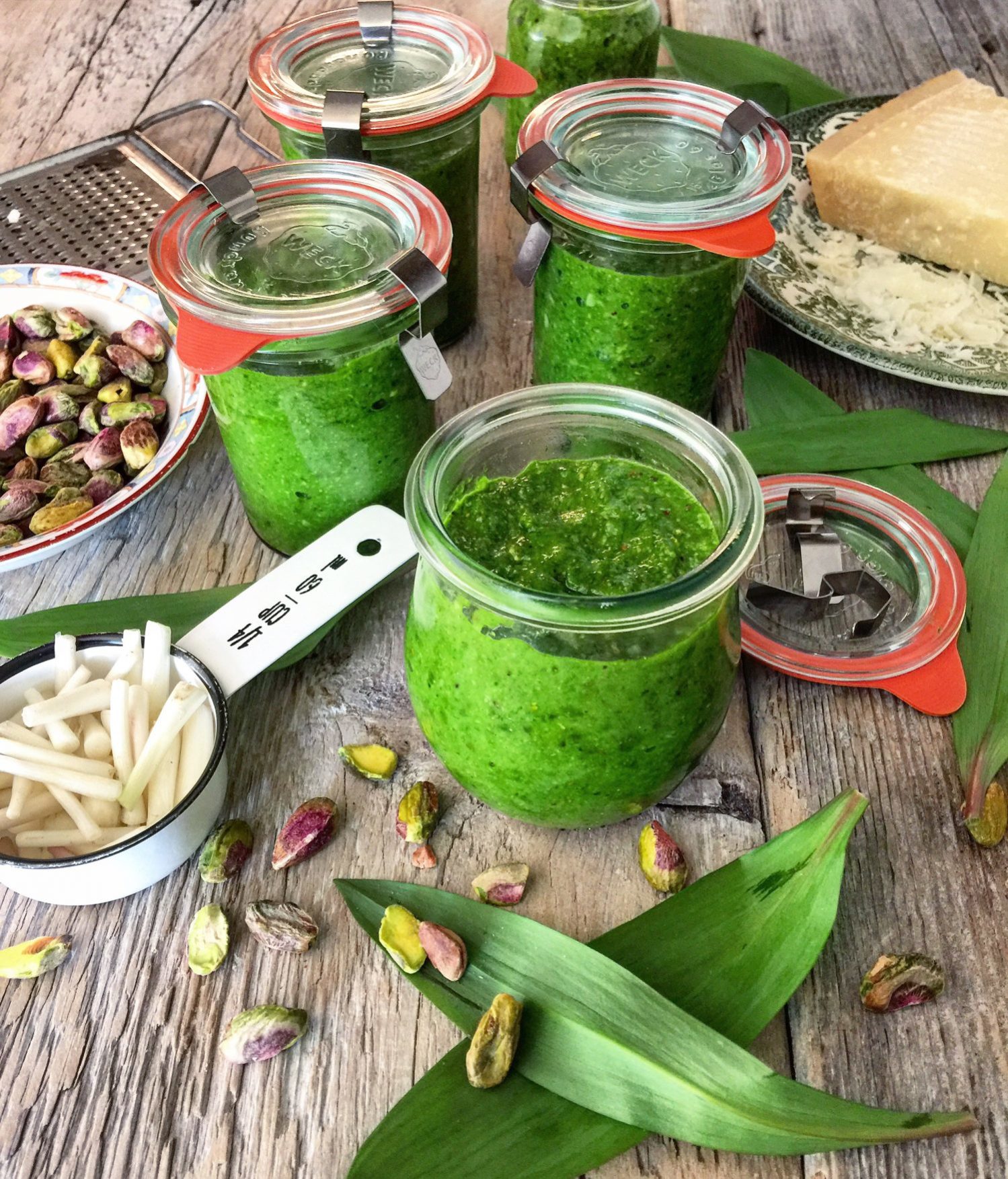

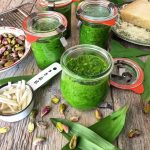
Ramp Pesto
Ingredients
- 3 cups ramp leaves, packed cups
- 1/2 cup olive oil, feel free to use more oil if you want a looser pesto.
- 1/3 cup pistachios
- 3 tbsp ramp whites, or 2 tbsp garlic, see Notes
- 1/4 cup freshly grated Parmesan cheese
- 1/4 cup freshly grated Pecorino Romano, or Parmesan cheese
- 1 teaspoon coarse kosher salt
Instructions
-
Combine first 4 ingredients in blender. Blend until paste forms, stopping often to push down ramp leaves.
-
Add both cheeses and blend till smooth. Taste, if needed, add the salt, you may not need any as the cheeses bring salt to the pesto.
This is a thicker pesto, so that you can adjust it with more oil when serving. Keeping it on the thicker side will allow for cooking with it, which will loosen it in the heat.
-
Transfer to one or two jars. Top with 1/4 inch olive oil. Seal and store in the fridge or freezer.
Recipe Notes
If you cannot source enough ramps you can make up the difference with basil leaves.
I do not over salt to begin with. You can always re-season as you cook with the pesto.
It is thick to begin with. The heat from the pan you are adding it to will loosen it a tad. But thin with oil, or pasta water for a smoother, runnier texture.
You can easily replace the greens with basil, arugula, even asparagus or broccoli.
Try pine nuts, walnuts, hazelnuts or even pecans instead of the pistachios.
You can freeze pesto in larger ice cube moulds. Once frozen transfer them all to a freezer bag. They'll be ready whenever you need them.
If using this recipe to guide you in any other version of pesto, use less garlic to begin with. Ramps are milder than actual garlic, so you want to start with maybe 2 tbsp of chopped garlic to begin with. It is always easier to add more as desired.
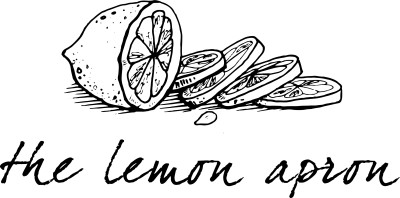
I have been taught when foraging ramps to take no more than 20%, and to it above the bulb leaving it in the ground d to grow back next year.
Hi Gail, Yes these past years has seen such a rise in popularity in ramps, that ever updated responsible foraging methods should be employed. Up here in Ontario we are especially blessed with quite an abundance of ramps. I’ve updated the blog article to include the suggested practises that are recommended here. We are allowed to remove the bulb with the plant as long as the patch we are working from is at least 6 feet square, and there are other patches in the forest nearby. Where I forage I barely scratch the surface, and really no one else will ever go there. But if you go where many others may be following, or the danger of depleting a patch is a real threat, then adjustments should be made. It is also allowed that you trim the ramp 1/4 inch above the root, if you do choose to leave the root intact. Hope this helps, Love Jen